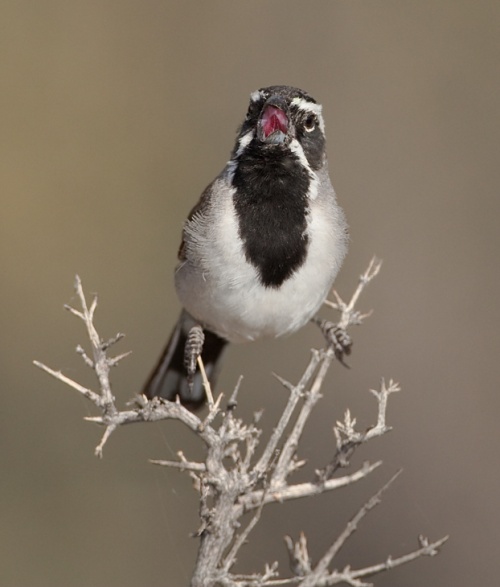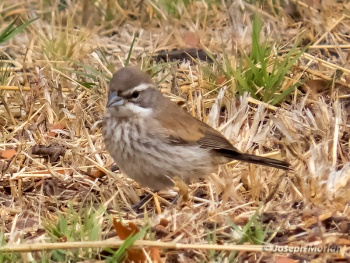Sbarnhardt (talk | contribs) (Amend Gsearch for new system,) |
|||
| (11 intermediate revisions by 4 users not shown) | |||
| Line 1: | Line 1: | ||
| + | [[Image:Blkthrspw2.jpg|thumb|500px|right|Adult <br />Photo © by {{user|digishooter|Mark Schmitt }}<br /> Kelso Valley, [[California]], [[USA]], 23 May 2009]] | ||
;[[:Category:Amphispiza|Amphispiza]] bilineata | ;[[:Category:Amphispiza|Amphispiza]] bilineata | ||
| − | |||
==Identification== | ==Identification== | ||
| − | + | ||
| + | 12-14 cm (4.7-5.5) in, 11-15 g<br /> | ||
| + | Gray-brown above, white below, with striking black throat and breast; 2 conspicuous white stripes on sides of head, 1 above and 1 below the eye.<br /> | ||
| + | Sexes alike. <br /> | ||
| + | '''Juvenile''' has a white throat and streaked breast, reminiscent of [[Sagebrush Sparrow]], but note longer more extensive white eyebrow on Black-throated. | ||
==Distribution== | ==Distribution== | ||
| − | Breeds from southern Oregon and Idaho southward to Baja California and central Mexico and central Texas. Also locally in Washington and central California. | + | '''Breeds''' from southern [[Oregon]] and [[Idaho]] southward to Baja California and central [[Mexico]] and central [[Texas]]. Also locally in [[Washington]] and central [[California]]. <br /> |
| − | [[ | + | '''Winters''' from southern [[Nevada]] and central [[Texas]] southward. |
==Taxonomy== | ==Taxonomy== | ||
| − | + | [[Image:Black-throated_Sparrow_frontview.jpg|thumb|350px|right|Photo © by {{user|rb_stern|Richard Stern}}<br />Borrego Springs, [[California]], [[USA]], 8 April 2007]] | |
| − | ''A. b. bilineata, A. b. opuntia, A. b. deserticola, A. b. bangsi | + | ====Subspecies==== |
| + | There are 10 subspecies, 4 of which are confined to islands in the Gulf of California<sup>[[#References|[1]]]</sup>: | ||
| + | *''A. b. bilineata: North-central [[Texas]] to north-eastern [[Mexico]] (eastern Coahuila, Nuevo León and Tamaulipas) | ||
| + | *''A. b. opuntia'': South-eastern [[Colorado]] to eastern [[New Mexico]], western [[Texas]] and north-western Coahuila | ||
| + | *''A. b. deserticola'': Arid west-central [[US]] to northern [[Baja]], islands in Sea of Cortés and north-western Chihuahua | ||
| + | *''A. b. bangsi'': Cape District of southern [[Baja California]] and adjacent islands | ||
| + | *''A. b. tortugae'': Isla La Tortuga (Gulf of [[California]]) | ||
| + | *''A. b. carmenae'': Isla Carmen (Gulf of California) | ||
| + | *''A. b. belvederei'': Isla Cerralvo (Gulf of California) | ||
| + | *''A. b. cana'': Isla San Estéban (Gulf of California) | ||
| + | *''A. b. pacifica'': Arid north-western [[Mexico]] (southern Sonora, northern Sinaloa and Isla Tiburón) | ||
| + | *''A. b. grisea'': West-central [[Mexico]] (Chihuahua to southern Coahuila, northern Jalisco, south-western Tamaulipas) | ||
==Habitat== | ==Habitat== | ||
| + | [[Image:Black-throatedSparrowIMG 0138.jpg|thumb|350px|right|Juvenile<br />Photo © by {{user|jmorlan|Joseph Morlan}}<br />Coyote Point, San Mateo, [[California]], [[USA]], 19 September 2020]] | ||
Arid uplands - common in canyons, badlands, flats, desert alluvial fans, washes and desert scrub, such as mesquite, ocotillo, chollo and sagebrush. Found in piñon-juniper forests at higher elevations (1,219–2,133 m). | Arid uplands - common in canyons, badlands, flats, desert alluvial fans, washes and desert scrub, such as mesquite, ocotillo, chollo and sagebrush. Found in piñon-juniper forests at higher elevations (1,219–2,133 m). | ||
==Behaviour== | ==Behaviour== | ||
| − | + | This species has adapted itself well to a life in the extreme habitat of its home range and is very tolerant of the heat and drought. | |
| + | |||
| + | After the rainy season, they scatter into small flocks | ||
| + | ====Diet==== | ||
| + | Consists of seeds vegetable matter and insects, which provide all the moisture they need, though they will take advantage of water holes when available. | ||
| + | ====Breeding==== | ||
| + | They raise their young in the dry upland desert. | ||
====Vocalisation==== | ====Vocalisation==== | ||
| − | Song : a series of two opening notes followed by a buzz or trill, or sometimes several. | + | Song: a series of two opening notes followed by a buzz or trill, or sometimes several. |
| − | |||
==References== | ==References== | ||
| − | + | #{{Ref-Clements6thAug19}}#Cornell Lab of Ornithology. 2019. Black-throated_Sparrow in: All About Birds. Cornell Lab of Ornithology, Ithaca, New York. https://www.allaboutbirds.org/ Accessed on 20 September 2020 | |
| + | #Johnson, M. J., C. van Riper, and K. M. Pearson (2020). Black-throated Sparrow (''Amphispiza bilineata''), version 1.0. In Birds of the World (A. F. Poole and F. B. Gill, Editors). Cornell Lab of Ornithology, Ithaca, NY, USA. https://doi.org/10.2173/bow.bktspa.01 | ||
| + | {{ref}} | ||
==External Links== | ==External Links== | ||
| + | Search the Gallery using the scientific name: | ||
{{GSearch|Amphispiza+bilineata}} | {{GSearch|Amphispiza+bilineata}} | ||
| + | Search the Gallery Using the common name: | ||
| + | {{GSearch|"Black-throated Sparrow"}} | ||
| + | {{GS-checked}} | ||
[[Category:Birds]][[Category:Amphispiza]] | [[Category:Birds]][[Category:Amphispiza]] | ||
Latest revision as of 17:25, 12 April 2022
- Amphispiza bilineata
Identification
12-14 cm (4.7-5.5) in, 11-15 g
Gray-brown above, white below, with striking black throat and breast; 2 conspicuous white stripes on sides of head, 1 above and 1 below the eye.
Sexes alike.
Juvenile has a white throat and streaked breast, reminiscent of Sagebrush Sparrow, but note longer more extensive white eyebrow on Black-throated.
Distribution
Breeds from southern Oregon and Idaho southward to Baja California and central Mexico and central Texas. Also locally in Washington and central California.
Winters from southern Nevada and central Texas southward.
Taxonomy
Subspecies
There are 10 subspecies, 4 of which are confined to islands in the Gulf of California[1]:
- A. b. bilineata: North-central Texas to north-eastern Mexico (eastern Coahuila, Nuevo León and Tamaulipas)
- A. b. opuntia: South-eastern Colorado to eastern New Mexico, western Texas and north-western Coahuila
- A. b. deserticola: Arid west-central US to northern Baja, islands in Sea of Cortés and north-western Chihuahua
- A. b. bangsi: Cape District of southern Baja California and adjacent islands
- A. b. tortugae: Isla La Tortuga (Gulf of California)
- A. b. carmenae: Isla Carmen (Gulf of California)
- A. b. belvederei: Isla Cerralvo (Gulf of California)
- A. b. cana: Isla San Estéban (Gulf of California)
- A. b. pacifica: Arid north-western Mexico (southern Sonora, northern Sinaloa and Isla Tiburón)
- A. b. grisea: West-central Mexico (Chihuahua to southern Coahuila, northern Jalisco, south-western Tamaulipas)
Habitat
Arid uplands - common in canyons, badlands, flats, desert alluvial fans, washes and desert scrub, such as mesquite, ocotillo, chollo and sagebrush. Found in piñon-juniper forests at higher elevations (1,219–2,133 m).
Behaviour
This species has adapted itself well to a life in the extreme habitat of its home range and is very tolerant of the heat and drought.
After the rainy season, they scatter into small flocks
Diet
Consists of seeds vegetable matter and insects, which provide all the moisture they need, though they will take advantage of water holes when available.
Breeding
They raise their young in the dry upland desert.
Vocalisation
Song: a series of two opening notes followed by a buzz or trill, or sometimes several.
References
- Clements, J. F., T. S. Schulenberg, M. J. Iliff, S. M. Billerman, T. A. Fredericks, B. L. Sullivan, and C. L. Wood. 2019. The eBird/Clements Checklist of Birds of the World: v2019. Downloaded from http://www.birds.cornell.edu/clementschecklist/download/
- Cornell Lab of Ornithology. 2019. Black-throated_Sparrow in: All About Birds. Cornell Lab of Ornithology, Ithaca, New York. https://www.allaboutbirds.org/ Accessed on 20 September 2020
- Johnson, M. J., C. van Riper, and K. M. Pearson (2020). Black-throated Sparrow (Amphispiza bilineata), version 1.0. In Birds of the World (A. F. Poole and F. B. Gill, Editors). Cornell Lab of Ornithology, Ithaca, NY, USA. https://doi.org/10.2173/bow.bktspa.01
Recommended Citation
- BirdForum Opus contributors. (2024) Black-throated Sparrow. In: BirdForum, the forum for wild birds and birding. Retrieved 19 May 2024 from https://www.birdforum.net/opus/Black-throated_Sparrow
External Links
Search the Gallery using the scientific name:
Search the Gallery Using the common name:
GSearch checked for 2020 platform.






